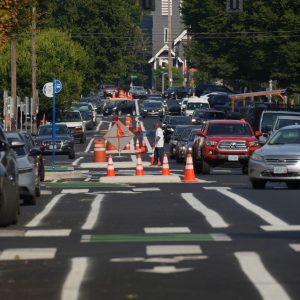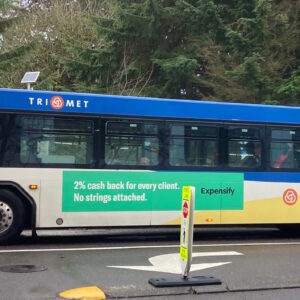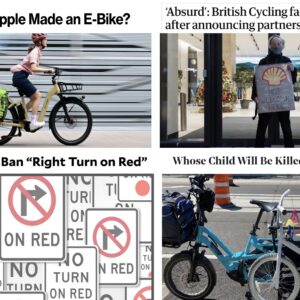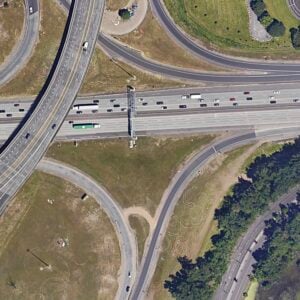For months now, the Oregon Department of Transportation has been reluctant to embrace the idea of re-allocating space on SW Barbur Blvd in order to improve traffic safety for all users. ODOT sees the road as a major arterial highway that must move as many people in cars as possible at all times (even though Interstate 5 is just a stone’s-throw away).
Back in December, when asked about the possibility of doing a “road diet” on SW Barbur, former ODOT staffer Jilayne Jordan told The Oregonian, “Barbur is the alternate route to Interstate-5, and we don’t like to reduce capacity on those routes.”
But now it appears even ODOT admits that having just one lane for driving in each direction instead of two would really not be that big of a deal.
ODOT announced their construction and detour plans this afternoon for the Newbury & Vermont Street Bridge Rehabilitation Project (which is slated to begin next spring). Here’s the section of the press release that caught my eye:
“… by placing mobile barriers on the bridges which will reduce traffic to one lane in each direction from 7 a.m. to 7 p.m… While the lane closures will cause some traffic congestion on Barbur (especially during rush hour) we feel that traffic will not be significantly impacted – especially over time as motorists adapt to the changes.”
Of course, the context here is that ODOT is trying to alleviate concerns from neighborhood residents about potential traffic impacts caused by the bridge project, so they have an interest in downplaying it. But if they openly admit they can make Barbur just one lane for driving in each direction for a month with “no significant impact” and that people will simply “adapt to the changes,” it seems like they should have no trouble seriously considering a road diet.
Perhaps someone should do modeling and observations of traffic flow during this construction period to see how it goes. Seems like if the sky doesn’t fall, and people simply change their driving behaviors, perhaps this could be seen as a trial period for a more permanent, corridor-wide lane reconfiguration?
As for bicycling over these bridges during the construction period, ODOT’s statement didn’t mention that at all. However, in a follow-up email, ODOT Community Affairs Coordinator Ed Sale said people riding bicycles will be expected to share the lane with drivers during the 30-day construction period. They also plan to reduce the speed limit to 35 mph. Hey, let’s make that permanent too!
I can’t wait to see how this turns out.







Thanks for reading.
BikePortland has served this community with independent community journalism since 2005. We rely on subscriptions from readers like you to survive. Your financial support is vital in keeping this valuable resource alive and well.
Please subscribe today to strengthen and expand our work.
Share the lane with 35 MPH traffic? No thank you.
Well. If anyone passes you they’d be breaking Oregon’s safe passing law, which require people to pass with enough space so that they don’t run over you if you were to fall over… which in my case means they’d have to give me about six-feet of clearance. That’d be impossible if there’s only one lane which means they have to stay behind. Of course, not everyone will “take the lane” and many folks are likely to ride too far to the right which will encourage people to try and drive past.
A couple thoughts on that, Jonathan:
The flip side of that is that if they’re doing 34 mph, drivers can pass you as close as they want. Hardly reassuring. I personally think that our passing law is toothless. The distance doesn’t apply if they’re doing under 35 or if the person on a bike is in a bike lane. This fits the VAST majority of riding in the city, meaning that there really is no passing law that applies to any riding in the city.
The other thing is, I would be curious if you could find out how many drivers have actually ever been cited for violating the passing law. My guess is that it is probably only used by an aggressive prosecutor after a driver has hit a person on a bike. Considering the lack or aggressive prosecutors around here, I’d put good money on this law being one of the least enforced traffic laws we have. It’s the kind of thing lawmakers pass so we’ll shut up. And we’re the suckers if we think it means anything.
Tony,
You repeat what I believe is an incorrect, but widely held interpretation of the passing law. ORS 811.410 requires a vehicle passing on the left to leave a safe distance, regardless of speed or other circumstances. ORS 811.065 defines the safe passing distance as the fall over distance for vehicles traveling faster than 35 mph. I agree that the law should have been written clearer and that enforcement should be stronger. However, drivers cannot legally pass a bicyclist as close as they want.
“…ORS 811.410 requires a vehicle passing on the left to leave a safe distance, regardless of speed or other circumstances. …… However, drivers cannot legally pass a bicyclist as close as they want.” AnotherDoug
A reading of the law’s text suggests the driver of a vehicle can pass a bicyclist or other vehicle as close as they want, as long as they consider the distance from the vehicle being passed, to be a “safe distance”; whatever feet or inches that may be. I don’t think Tony is misinterpreting the law.
http://www.oregonlaws.org/ors/811.410
I guess it’s legal, but it tends to startle and upset me a bit, or more when someone driving a motor passes me within arm’s reach or less, especially when they’re traveling at speeds up to…what is it? 34mph? For someone traveling on a bike at 10-20 mph, that’s a huge speed differential, consequences of which do nothing positive to encourage use of bikes for travel on roads alongside motor vehicles.
It is not up the the driver to decide what constitutes a safe distance. This is the same statute used to cite drivers who cut in front of trucks. The problem isn’t so much that the law doesn’t protect us. It’s that the cops are more interested in protecting truckers than in protecting bicyclists.
Yes, the safe distance is not up to the driver, but the law gives three specific exceptions when the distance does not apply.
“It is not up the the driver to decide what constitutes a safe distance. …” AnotherDoug
The law says that determination is up to the driver, based on their personal discretion. Law enforcement personnel, or other road users, may take exception to a particular driver’s demonstration of what constitutes a safe passing distance, possibly leading to a citation and in court, a review of the driver’s decision, leading to a fine, etc.
Behind the wheel of the moving vehicle though, and absent more specific distance specifications in the law, good or bad, determination of safe distance away from another vehicle in passing, relies on the driver’s discretion.
I would love to be wrong, but I really don’t think I am. The way I read this is that they mandate the safe distance but then offer several exceptions, two of which are stated here.
(1) A driver of a motor vehicle commits the offense of unsafe passing of a person operating a bicycle if the driver violates any of the following requirements:
(a) The driver of a motor vehicle may only pass a person operating a bicycle by driving to the left of the bicycle at a safe distance and returning to the lane of travel once the motor vehicle is safely clear of the overtaken bicycle. For the purposes of this paragraph, a ‘safe distance’ means a distance that is sufficient to prevent contact with the person operating the bicycle if the person were to fall into the driver’s lane of traffic. This paragraph does not apply to a driver operating a motor vehicle:
(A) In a lane that is separate from and adjacent to a designated bicycle lane;
(B) At a speed not greater than 35 miles per hour
According to the Swanson, Thomas, Coon & Newton website:
“Specific exclusions from the new law are traffic lanes next to a bicycle lane, speeds below 35 mph, or when the bicyclist is turning left. The 35 mph speed limit was a compromise to allow city transit services to travel more closely to bicyclists in a low speed urban environment.”
tonyt,
It seems to me that you are not considering the applicability of ORS 811.410 in those situations in which ORS 811.065 does not apply. The Thomas discussion deals only with ORS 811.065 and describes the situations in which “safe distance” is defined as fallover distance. While “safe distance” is not defined for other situations, ORS 811.410 still requires motorists to leave a safe distance when passing. The absence of any quantification of what constitutes a safe distance leaves that to the judgement of the cops and courts. You won’t get any argument from me as to whether that is adequate or whether we have effective enforcement of the laws. But, I am confident that it is not legal for a motorist to come within inches of clipping us with their mirror if they are only doing 34 mph.
You might want to check out the portion of http://www.stc-law.com/bicyclepassinglaws.html addressing “What About When the Bicycle Passing Law Does Not Apply?” toward the bottom.
ORS 811.065 defines a safe passing distance “For the purposes of this paragraph” which means that the definition does not apply to ORS 811.410…
I am curious if there is any traffic violations related to impeding the flow of traffic. For example, if a car was traveling at 15mph in a 35mph zone and holding up several cars behind it would that be a violation.
Mike,
Only if the slower vehicle fails to move into an “area sufficient for safe turnout” when that opportunity becomes available. (ORS 411.425)
Thanks for the clarification. Taking the lane is often, if not always, used as a demonstration of defiance in the name of safety. I am all for taking the lane but is it responsible to let the faster traffic pass? Also, what is a safe turnout as defined by the law?
The above discussion is rather moot. The great majority of drivers do not know, nor likely care, what the law states. Whenever possible, TAKE THE LANE.
Jonathan,
Recently I reviewed the yearly totals of citations written on safe passing law from 2008. They averaged from 1-3 per year.I would not be shocked to find out that these were issued after an accident. I have also spoken with several PPB officers about this law and none of them seem to have any experience with it. Seems a lot of education to everyone is needed on this law.
PS can pass on the stats etc.. if you like.
2008 to present
sbrock, where did you find this data? I’ve looked a bit for this type of thing but never with any sucess. Did you have to request it from PPD?
Again, when taking the lane, at what point does it become against the law to hold up traffic. When driving a car you can get a ticket for impeding traffic so wouldn’t it be true for riding a bike?
This is a perfect opportunity to study the operations of a road diet on this roadway.
Is ODOT or PSU or citizen cyclists…ready to set up some cameras, tube counters, or other old tech to study this vs. modelling or gut feelings?
I think that could be a great PSU student project!! Somebody should contact Jennifer Dill about it 🙂
if ODOT thinks that motorists can adopt to a slower speed limit while also sharing only a single lane with bicycles then they really have no excuse for not putting Barbur on a permanent diet…
The project scedule is appx 1.5 years…
My concern is biking through the 1 lane construction zone at night or on wkds when the contractors are not working, when there is no congestion or incentive for vehicles to slow down.
If they don’t need the lanes from 7am-7pm, they should keep them closed in the evening too, allow people to ride in the closed lanes, and mobile construction lights on the bridges.
On SW Barbur Blvd:
Henry Schmidt: hit around 1AM.
Angela Burke: killed by driver Caleb Pruitt was driving his 2008 Subaru Impreza at night
Lance Marcus: died on Tuesday night after driving his car into a power pole on SW Barbur Blvd near Miles Street.
Obviously a big part of the Barbur problem occurs at night when the road is under lit and empty enough to be driven like an empty country road.
It needs to be made to look like a brightly lit city street where something could jump out from anywhere at any time of the day.
At night this stretch of Barbur looks and drives just like a back country speedway.
“At night this stretch of Barbur looks and drives just like a back country speedway.”
For better and worse, that is by design. From http://barburblvd.blogspot.com/:
“The highway [from Bertha Blvd. into town] was designed to have a scenic feel to it as people drove into Portland. For this reason, the adjacent property along the highway was “zoned down” to thin out businesses and offer greenery as they entered Portland from the south … A beautiful canopy of trees welcomed motorists as they descended into town.”
That’s all fine and good before 1961 when I-5 was opened but in the intervening 52 years it has become obvious to even FHWA & USDOT engineers that long straight stretches of pavement encourage driving faster than is safe or the engineers originally intended.
Further, this quaint notion of lulling drivers in to a sense of calm pastoral country driving is exactly the opposite of what we kno needs to be done here.
Perhaps before I-5 opened, when traffic on this stretch was bumper to bumper slow and more than 75% of drivers were rural drivers that a DOT didn’t want to have a panic attack on their first visit to The Big City, perhaps then a soothing country scene coming into Portland was a good idea.
Nowadays people are plenty well adapted to urban driving vs rural driving and our behavior belies this fact. In urban areas people drive with care because anything can happen; in the country speed limits are optional because no one is around to see or get hurt.
What I’m saying in effect is that if the design for this portion of Barbur requires that it looks like a backwoods highway then THAT is the enemy.
Every element of the visual layout is geared towards making drivers feel safe going as fast as they want whenever they want.
SW Barbur Blvd needs to be made to feel less safe, more urban and much less like a car only playground.
This is so hard to read….”no big deal”…then get it done, be done with it…make it safer…you could do it tomorrow…..why wait…why why why? I totally do not get it. AAAARRGGGHHHH!!!
It’s funny in a way, the point this bikeportland story raises, about ODOT’s wavering, contradictory position on the debatable need for Barbur Blvd to have two main high speed lanes used primarily by motor vehicles, for both directions.
As others commenting here have already essentially suggested: On a long term basis after already scheduled repairs to the road are made, ODOT should seriously consider closing to motor vehicle use, one lane in each direction, assigning those lanes primarily to active transportation use. In one clean sweep, this would make Barbur Blvd possibly the best metro area inter-city bike route.
If for some good reason, two lanes on Barbur couldn’t sufficiently handle daily motor vehicle volume needs, change back to the four main lane configuration
…ODOT should seriously consider closing to motor vehicle use, one lane in each direction, assigning those lanes primarily to active transportation use.
The Friends of Barbur proposal is to remove one of four lanes total, leaving three total (two south/uphill, one north/downhill) plus bike lanes on both sides. It’s illustrated at the top of their website: http://www.friendsofbarbur.com/ .
Why are there no sidewalks on this portion of road?
Does ODOT ever do trial lane closures? I’ve seen a city put up big cones to close a lane on a busy urban highway before — in this particular case I’m thinking of, I though they were planning on doing construction, but in retrospect it looked instead like they were testing to see how severely car traffic would be affected if they were going to expand a separated bike/ped trail through the area. The cones showed up and stayed for a whole month last year, but the construction project didn’t happen until two weeks ago.
Of course there have been lane closures – everytime they repave an interstate, they close the lanes being paved! They even closed the I-5 Columbia River bridge for a few days/weeks years ago.
With regards to the speed limit, it would seem that 25 or even 20MPH would seem more appropriate, along with a doubling of traffic fines as is common would help encourage drivers to comply. This is a major project that cuts traffic lanes in half. A mere 10mph reduction seems inadequate.
ODOT did a study during the St. John’s bridge rehabilitation in 2005 that found reducing the lanes to two would not significantly impact traffic volumes.
So.
Good luck with Barbur.
I wish these roads could be given over to the city, but that is probably even less likely than ODOT actually doing any traffic calming.
Remember to cc your comments, concerns and suggestions to ODOT —
askodot@odot.state.or.us
http://highway.odot.state.or.us/cf/comments/comments.cfm
Ted Buehler
I think this illustrates the culture within ODOT very well, in that there is NOT a unified management that provides direction, but in fact different project teams who compete with each other and likely totally disagree and do not communicate well at all with each other. Those different teams and individuals and their resulting inter-turf wars are what creates the bureaucratic inertia and resistance to change, among other things.
Sounds like the bike/pedestrian advocates should try to find key alliances within the bureaucracy to succeed in their goals, not treat ODOT like a singular entity, which it is not.
I have family who works there, and the stories can be very illuminating.
ODOT’s initial attitude is their default attitude for anything that might restrict capacity for autos and increase capacity for everyone else. “We can’t do that!!! It will create anarchy and the world will come to an end!!!” But of course we know otherwise as we have many examples in the US and internationally. Sadly the farther one travels from Portland the stronger ODOT feels that we absolutely can not reduce road capacity for cars. For an excellent example look at the proposed 3rd bridge in Salem.
Jonathan, could you put a link directly to the press release you quote? I can’t seem to find it on the project web page.
I would like to be able to reference the document when I complain to ODOT about their doublethink nonsense.
The construction will not provide a good test demonstration of the Barbur “road diet” because ODOT is keeping all lanes on Barbur open during rush hour.
ODOT is also taking pains to route detoured automobile traffic a long way around, avoiding the most direct detour; Terwilliger. It is Terwilliger (a very popular bicycle route) that stands to be most adversely affected by increased traffic in the event a real Barbur road diet. (To its credit, ODOT is avoiding impacts to Terwilliger during construction in response to public comments.
A couple of points:
Oregon’s safe passing law is unsafe. Invariably a car will want to pass a cyclist on a blind hill or curve. Fearing some kind of assinine ticket for passing too close they get too far over into the lane of opposing traffic, causing a potential head-on collision that could kill the car occupants and the cyclist. I want cars to get over far enough to not hit me, and that’s good enough – just don’t hit me. I don’t want to be the cause of a serious accident.
Barbur Blvd is a busy and important bypass for I-5 when there is a problem which is about every day during rush hour – leave the car lanes as they are and work on widening bike lanes if needed.
Cyclist need to do their part for safety: good lights, high viz yellow and orange clothing, etc. If the cars can see you then 99.99% of the time they will not hit you. AND ride as far to the right as practical.